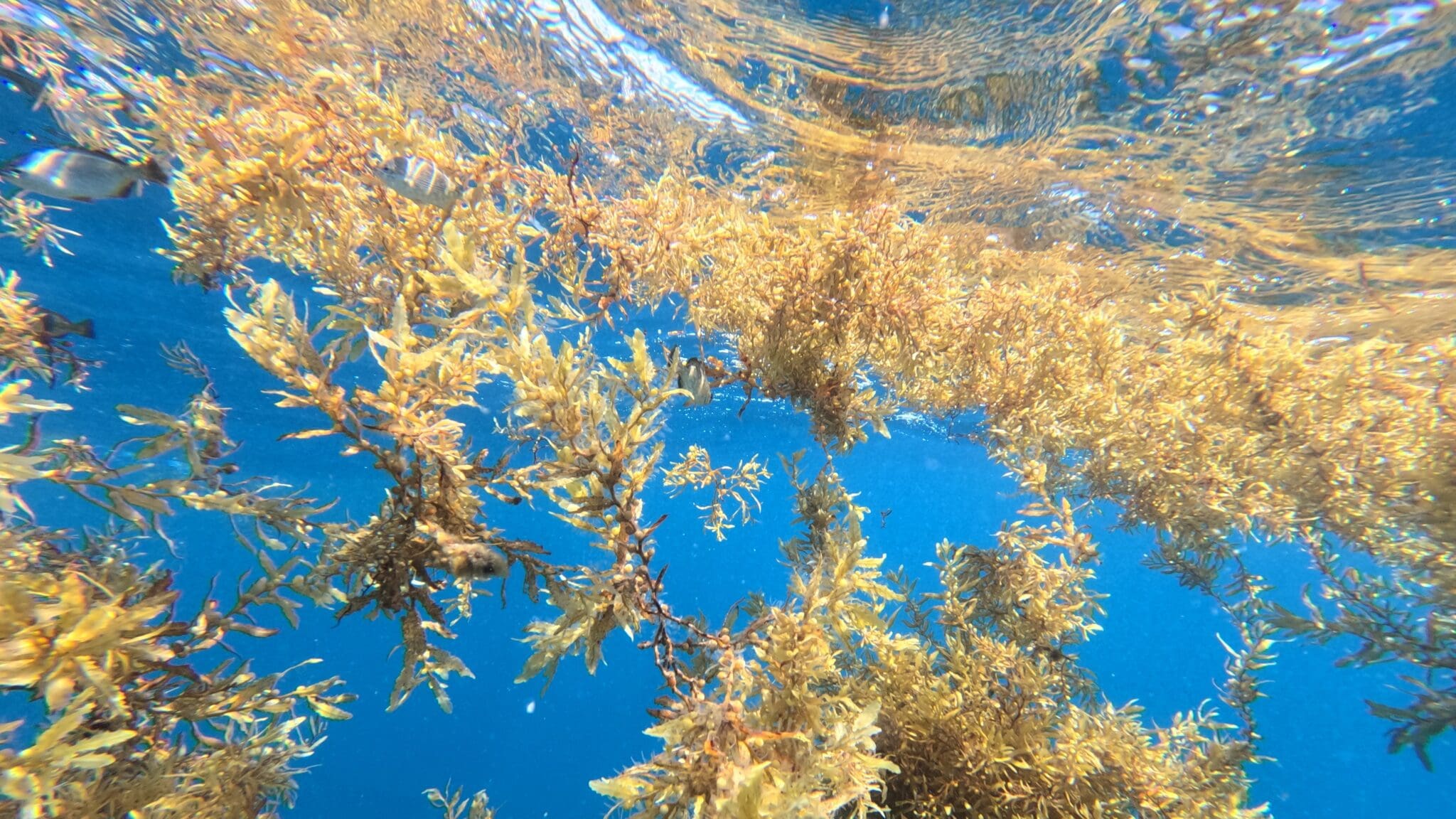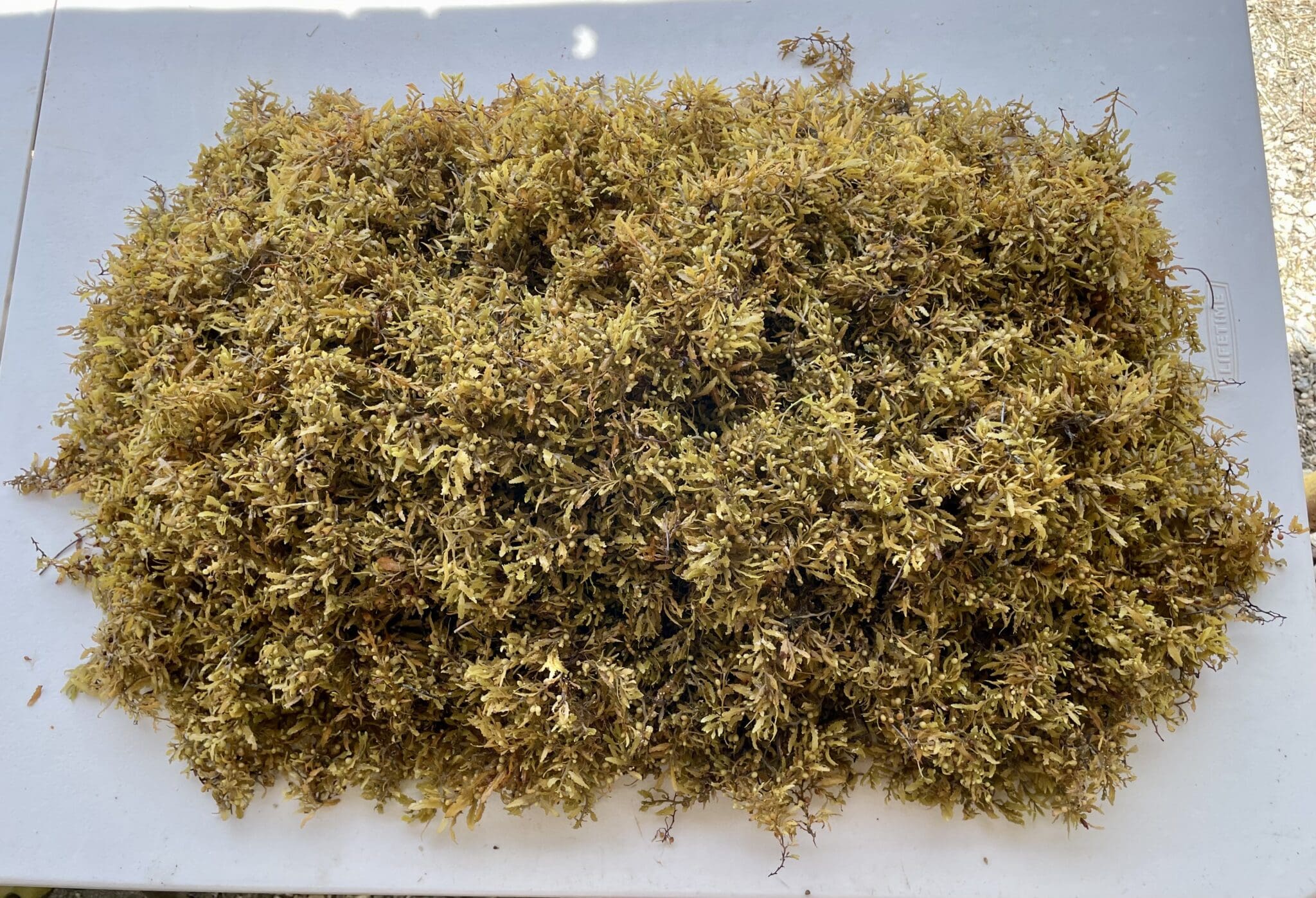Transforming Troublesome Seaweed into a Feedstock of the Future

Since 2011, enormous seaweed blooms have spread across the Atlantic Ocean, spanning over 5,000 miles from West Africa to the Gulf of Mexico.
Known as the Great Atlantic Sargassum Belt, the leviathan — visible from space — has wreaked havoc on environments and economies throughout the Caribbean Sea and Gulf of Mexico, where unprecedented quantities of seaweed routinely break away from the mat, wash ashore, and decay. In 2018 alone, attempts to clean up the errant seaweed from beaches across the Caribbean Sea totaled around $120 million.
A research team led by Princeton University aims to reimagine Sargassum — the culprit behind the massive blooms — from an economic and environmental burden into a boon. Armed with a grant from Schmidt Sciences and the Foundation for Food & Agriculture Research, researchers from eight institutions and an industry partner will develop technologies to transform the seaweed into a feedstock of the future, capable of producing valuable materials including fuels, chemicals, fertilizers, and other products.
“Much like how petroleum is converted into different fuels and petrochemicals in an oil refinery, we hope to develop a ‘biorefinery’ to transform Sargassum into several sustainable products used in everyday life,” said lead investigator José Avalos, associate professor of chemical and biological engineering and the Omenn-Darling Bioengineering Institute, as well as associated faculty at the Andlinger Center for Energy and the Environment. “We have the opportunity to turn something that’s been an economic and environmental disaster into a long-lasting, sustainable solution.”
The research project is one of five funded through the Virtual Institute on Feedstocks of the Future initiative, which supports science and technology research towards the use of currently underutilized sources of biomass as alternative feedstocks for biomanufacturing. Schmidt Sciences and the Foundation for Food & Agriculture Research have committed up to $47.3 million over five years to the projects supported by the institute.
A challenge and an opportunity
 Floating Sargassum in Puerto Rico (photo courtesy of Loretta Roberson of Marine Biological Laboratory).
Floating Sargassum in Puerto Rico (photo courtesy of Loretta Roberson of Marine Biological Laboratory).
The Sargassum of interest — a type of free-floating brown algae — is not always a problem. When floating in the open ocean, it provides a unique ecosystem for a host of marine life, being designated in some areas as essential habitats for a wide variety of fish and as critical habitat for loggerhead sea turtles.
The issues arise when the seaweed is carried to shore by winds or currents. There, the seaweed produces rotten egg-smelling hydrogen sulfide as it decays, deterring tourists, swimmers, and other beachgoers. These ‘brown tides’ also smother other flora and fauna and can clog critical infrastructure. For instance, the U.S. Virgin Islands declared a state of emergency in 2022 when a Sargassum buildup threatened the water intake pipe of a desalinization plant.
Because there are currently few good uses for Sargassum, today’s costly remediation efforts typically involve collecting the seaweed and then storing or disposing of it in landfills.
Despite their presence in landfills, Avalos said the seaweed contains many sugars and other compounds that can be converted into useful substances. It could even have some advantages over traditional land plants. For instance, Sargassum does not contain much lignin, a polymer that provides structural support to nearly all land plants yet is difficult and expensive to break down. And unlike terrestrial plants, Sargassum does not require fresh water, fertilizers, or large swathes of land that could be used for other purposes.
“Compare any land-based crop to seaweed, and especially a seaweed that is out of control,” Avalos said. “You don’t need land. You don’t need water. You don’t need nutrients. And they have little to no lignin. It’s an enormous opportunity.”
Such benefits notwithstanding, working with Sargassum presents its own challenges. The seaweed has diverse sugar polymers — alginate and fucoidan, among others — that pose difficulties in breaking down.
One of the goals of the project is to identify organisms that produce enzymes capable of breaking down these complex sugars in Sargassum into simpler ones. Once identified, the enzymes can be characterized and then engineered to have better properties and performance.
“The collaborative effort to develop novel biotechnology and bioengineering tools to manage the grand environmental challenge of Sargassum is vital to maintaining a viable ecosystem in our waters,” said Shishir Chundawat, an associate professor of chemical and biochemical engineering at Rutgers University, who is leading the efforts to characterize, design, and synthesize scalable Sargassum-degrading enzymes alongside Sagar Khare, a professor of chemistry and chemical biology at Rutgers. “The utilization of renewable seaweed biomass as feedstock for biorefineries has important implications for various energy, food, health, and advanced materials-related applications while allowing our team to simultaneously develop next-generation tools for enabling more sustainable industrial biotechnology,” Chundawat added.
Another challenge is Sargassum’s maritime life cycle. While Chundawat and Khare will work to design high-performance enzymes for degrading Sargassum, Debashish Bhattacharya, a distinguished professor of biochemistry and microbiology at Rutgers, will investigate microorganisms that can grow on the salty seaweed, including during its decay. Chundawat and Bhattacharya are affiliated faculty at the Rutgers Climate and Energy Institute. Khare, Bhattacharya, and Chundawat are also affiliated faculty at the Rutgers Institute for Quantitative Biomedicine.
Collaborating with Yasuo Yoshikuni, a scientist at Lawrence Berkeley National Laboratory, Avalos will then optimize the most promising salt-tolerant microorganisms that naturally consume Sargassum and study the chemicals they make as they ferment the seaweed feedstock. The duo will also engineer the salt-tolerant yeast strains so they can utilize the sugars released by the Sargassum-degrading enzymes and convert them into valuable products they do not naturally make, ranging from jet fuel precursors to cosmetics and pharmaceuticals.
At the same time, collaborator Clifford Louime, professor of environmental sciences at the University of Puerto Rico, will explore salt-tolerant options for anaerobic digestion, a process in which microorganisms feed directly on decomposing Sargassum without the presence of oxygen, producing methane-rich biogas and nutrient-rich fertilizers among other byproducts.
Louime will also work with Ah-Hyung (Alissa) Park, professor of chemical and biomolecular engineering and the Ronald and Valerie Sugar Dean of the UCLA Samueli School of Engineering, and Aaron Moment, associate professor in-residence of materials science and engineering at UCLA, to investigate thermochemical treatments for converting the remaining, unprocessed Sargassum into products such as bio-hydrogen, solid carbon (e.g., carbon nanotubes) and mineral carbonates (e.g., building materials that can store carbon). These thermochemical treatments include hydrothermal liquefaction, a process for converting the wet seaweed into a crude-like oil, and alkaline thermal treatment, a potentially negative emissions process for converting the seaweed into bio-hydrogen.
Some of the Sargassum harvested or cultivated in the ocean will have increased metal concentrations. For those seaweeds, Moment will deploy treatments to extract and separate critical metals, including the rare earth elements needed for batteries and other electronic devices, while addressing environmental issues such as arsenic abatement.
Moment and Park said the highly integrated seaweed conversion technology will maximize atomic and energy efficiencies and minimize waste while capturing, utilizing, and sequestering bio-carbon from an important renewable feedstock.
A solution for today and tomorrow
 A key aspect of the project involves refining methods for collecting, processing, and cultivating Sargassum (photo courtesy of Loretta Roberson of Marine Biological Laboratory).
A key aspect of the project involves refining methods for collecting, processing, and cultivating Sargassum (photo courtesy of Loretta Roberson of Marine Biological Laboratory).
Avalos said a key strength of the team is its broad-ranging expertise, from Sargassum biology and cultivation to techno-economic and life cycle analyses.
Beyond developing the various processes for converting Sargassum into valuable products, Loretta Roberson, an associate scientist at Marine Biological Laboratory and expert in seaweed biology and cultivation, will work closely with Bhattacharya, Louime, and Daniel Robledo Ramírez, a Sargassum biology researcher and team leader at the Mexican research institution CINVESTAV, to study the regional and seasonal variations of Sargassum and refine methods for collecting, processing, and cultivating Sargassum.
As the team develops and refines its methods for collecting, processing, and converting Sargassum into valuable products, it will analyze the costs associated with each process to pave the way for future scale-up and commercialization. The effort, led by Hauke Kite-Powell, a research specialist from Woods Hole Oceanographic Institution, in collaboration with industry partner Carbonwave, also includes studying the greenhouse gas emissions generated from the overall process to ensure its environmental sustainability. Together, these analyses will inform the direction of the research project and identify priority areas for improvement.
While the seaweed currently threatens the livelihoods of many across the Gulf of Mexico and the Caribbean Sea who depend on the surrounding ecosystems for tourism, fishing, or other uses, the researchers said they believe their biorefinery process could ultimately support a new type of sustainable economic growth across the region.
“The transformation of Sargassum from an environmental and economic challenge into a valuable feedstock is not just a possibility; it is a necessity,” said Louime from the University of Puerto Rico. “By harnessing the unique properties of this abundant seaweed, we can develop sustainable solutions that benefit both our environment and our economy. Our work aims to turn these problematic algae into a cornerstone of green innovation, paving the way for a future where Sargassum is seen as a vital resource rather than a nuisance.”
The project, “Sargassum seaweed as a future renewable feedstock for sustainable biomanufacturing,” was one of five supported through the Virtual Institute on Feedstocks of the Future. For more information, visit https://www.schmidtsciences.org/viff/.
